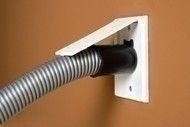 (MCT)—If you own a portable vacuum, do you ever wonder just how clean it’s really getting your home?
(MCT)—If you own a portable vacuum, do you ever wonder just how clean it’s really getting your home?
Chances are it’s not getting it as clean as you thought.
“Portable vacuum systems, regardless of the manufacturer and whether you buy a $100 (vacuum) or a $1,500 (high-end) vacuum, they all have exhaust and that exhaust comes back into your home,” said Aaron Doran with The Vac Dudes in Aliso Viejo, Calif. “So, as you vacuum, you have particles coming back into the living environment.”
With a central vacuum system, though, all of that dirt and dust is instead exhausted outside the home, creating a cleaner indoor living environment and eliminating the potential for respiratory issues.
“Anything that you pick up — either from the carpeting or the air from the room that you’re vacuuming — is exhausted outside the living area,” said Tom Proctor of Central Vacuum Experts in Chapel Hill, N.C. “There’s no other vacuum that does that. We sell higher quality portable vacuums; but even (ones) with a high filtration, you’re still exhausting that air back into the room where you’re vacuuming.”
Also known as whole-house vacuums, central vacuum systems consist of a large motorized canister system that is typically located in a garage, attic or basement. Pipes that run through the interior walls connect to the canister. Suction ports, which resemble electrical outlets, are located along walls and connect to the pipes. Homeowners can then detach and reattach a hose at the different suction ports, flip the power switch and begin vacuuming, eliminating the need to lug a heavy vacuum from room to room. The hose sends the debris through the pipes and into the canister. Many newer systems feature retractable hoses, so you no longer need to drag the hose from room to room.
“If you spill something 10 feet away from the vacuum inlet you can just pull 10 feet of hose out, vacuum it up and put it back in the wall again,” Doran said of the retractable hose feature. “They’re very effective at cleaning. You’re going to have a have a very clean home if you switch to central vacuums.”
Some other features of central vacuums include tools to vacuum pet hair, floor tools to get to hard-to-reach places and a baseboard suction port, in which you can sweep dirt into the port, which sucks it into the canister.
Central vacuum motors are more powerful than portable vacuum motors and the systems are much quieter, as well. Plus, they last much longer. Most manufacturers offer 15-year warranties. A central vacuum system can cost between $1,500 and $3,000 installed, on average, depending on accessories, features and the number of inlet valves installed. Most contractors recommend one inlet valve per 700 square feet.
“Most people are going to keep it for 20 years,” Proctor said. “People like the quietness. They also like the fact that you have a lot more powerful motor. It does add value to the house. It’s an amenity.”
Central vacuums are easiest to install during new construction; however, many companies can retrofit an existing home with minimal construction to accommodate a new system. It’s important homeowners who are interested in investing in a central vacuum system find a company that has a good local reputation and is qualified to do the installation. Look for a company that can provide proof of training from the product manufacturers, or certification on installation of central systems from the Vacuum Dealers Trade Association. Check that the company is insured, and if required in your area, licensed.
“You do have to have somebody who knows what they’re doing,” Proctor said. “One of the important things that we see when it’s not done right is people took shortcuts to getting it installed. They either didn’t glue the fittings or they (laid the pipes incorrectly). It’s not just a matter of remembering to glue everything, but to do it in an installed pattern that makes sense to the customer. You want to have somebody reliable; someone who’s been doing it a while and has a good reputation within the community.”
Angie Hicks is the founder of Angie’s List, the nation’s most trusted resource for local consumer reviews on everything from home repair to healthcare.
© 2013, http://www.angieslist.com/
Distributed by MCT Information Services










